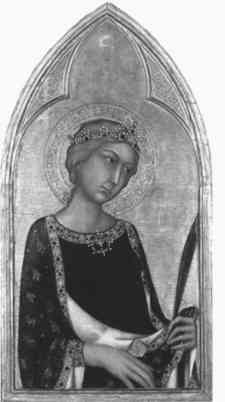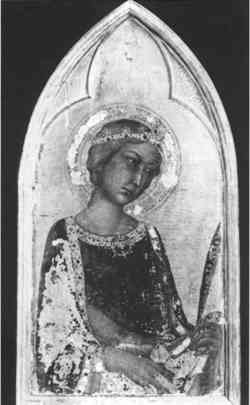THE RESTORATION OF THE EARLY ITALIAN “PRIMITIVES” DURING THE 20TH CENTURY: VALUING ART AND ITS CONSEQUENCESCATHLEEN HOENIGER
3 A TREATMENT BY STEFANO BARDINI IN THE 1870SThe radical cleanings carried out in many 20th-century restorations of early Italian works can be highlighted, initially, through comparison with an example of an aesthetic restoration performed in the late 19th century. The virtually invisible and polished restoration of Simone Martini's St. Catherine of Alexandria (ca. 1322–23), now in the National Gallery of Canada in Ottawa, illustrates how one 19th-century restorer was happy to reconstruct a heavily damaged early panel in a seamless way (figs. 1, 2). The panel was renewed, probably in the 1870s, when it was part of the collection of the Florentine artist and antiquarian Stefano Bardini (Brink 1979–80). Large patches of loss in the saint's proper right hand, the left portion of her mantle, and the tooled halo were recreated using abbreviated simulations of the original techniques and are now barely distinguishable from a normal viewing distance. For the halo, water-based gold-colored paint was brushed into the areas of loss, the lines of the tooling were recut, and red Siena paint was used to imitate the effect of red bole beneath worn gilding. The restoration harmonizes with the original goldwork because the viewer's eye naturally rotates continuously around the circle of the halo, thus allowing for integration (Ruggles 1997).
Bardini seems to have had the painting carefully reworked—or he may have even restored it himself—before the sale to the prince of Liechtenstein, Johannes II (1840–1929); in about 1880. It is difficult to determine whether the polished and complete restoration chosen in this instance relates most specifically to Bardini's training and practice, prevailing restoration philosophy, or the desires of his client the prince of Liechtenstein. All three contingencies may have contributed. Bardini's training was quite typical for restorers during the 19th century. He trained as a painter and expert copyist, learning through the study of historical techniques how to restore works invisibly for the art market. Bardini studied painting at the Accademia di Belle Arti in Florence beginning in 1854. There, under the romantic revival of interest in medieval and Renaissance art, students were encouraged to reproduce past works in their original techniques, either faithfully or in freer modern interpretations, in order to understand the paintings in a purely technical sense. A specific class was also given over to teaching the art students the craft of reproducing or restoring old works of art, whether painting or sculpture (Scalia and De Benedictis 1984). In 1881, when Bardini acquired the Florentine deconsecrated church and convent of San Gregorio, transforming them into his magnificent private gallery, the Palazzo Bardini, he set aside a large studio space that functioned as a laboratory for the restoration and reproduction of works of art. Whether Bardini and his workshop actually produced forgeries to deceive remains unclear. A market certainly existed among the middle classes for reproductions of original works at this time. However, it is somewhat incriminating that Bardini's close friend during the 1870s and early 1880s, the artist and dealer Angiolo Tricci, is strongly suspected of having forged and sold works of art (Scalia and De Benedictis 1984). The restoration treatment carried out under Bardini on Simone's St. Catherine has been described by Alessandro Conti ([1973] 1988, 315) as a “falsification” because of the way extensive damages are concealed. But this evaluation seems rather harsh because invisible inpainting was a widespread practice among late-19th-century restorers and was, indeed, part of their training. Between 1874 and 1922, Bardini amassed a rich collection of Italian paintings, some of which he kept and others of which were offered for sale. Included among these were a significant number of early Italian works, not yet fashionable among collectors. The National Gallery in London, for instance, now owns six Italian paintings datable before 1500 that can be traced back to Bardini's collection in Florence (Davies 1961, 599). Giovanni di Paolo's stunning Coronation of the Virgin, now in the Lehman Collection of the Metropolitan Museum of Art, New York, was in Bardini's collection The prince of Liechtenstein, however, may have had particular tastes when he purchased the Simone in about 1880. One other early Sienese panel discovered by the prince, Naddo Ceccarelli's Christ as the Man of Sorrows, acquired in 1892 from the Ciseri collection in Florence, reveals a taste for the decorative and exquisite craftsmanship characteristic of Simone Martini and his most talented followers (Christiansen et al. 1985). The prince may well have ordered the invisible restoration of Simone's St. Catherine, feeling that the losses inhibited appreciation of the graceful, aristocratic figure by marring the enamel-like finish. |

